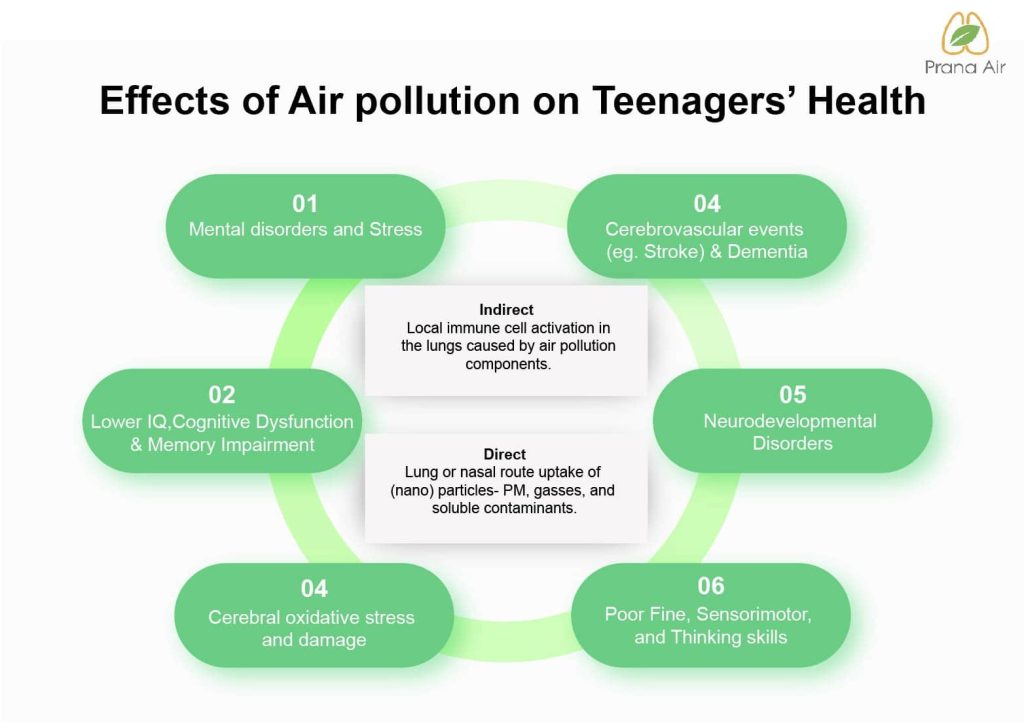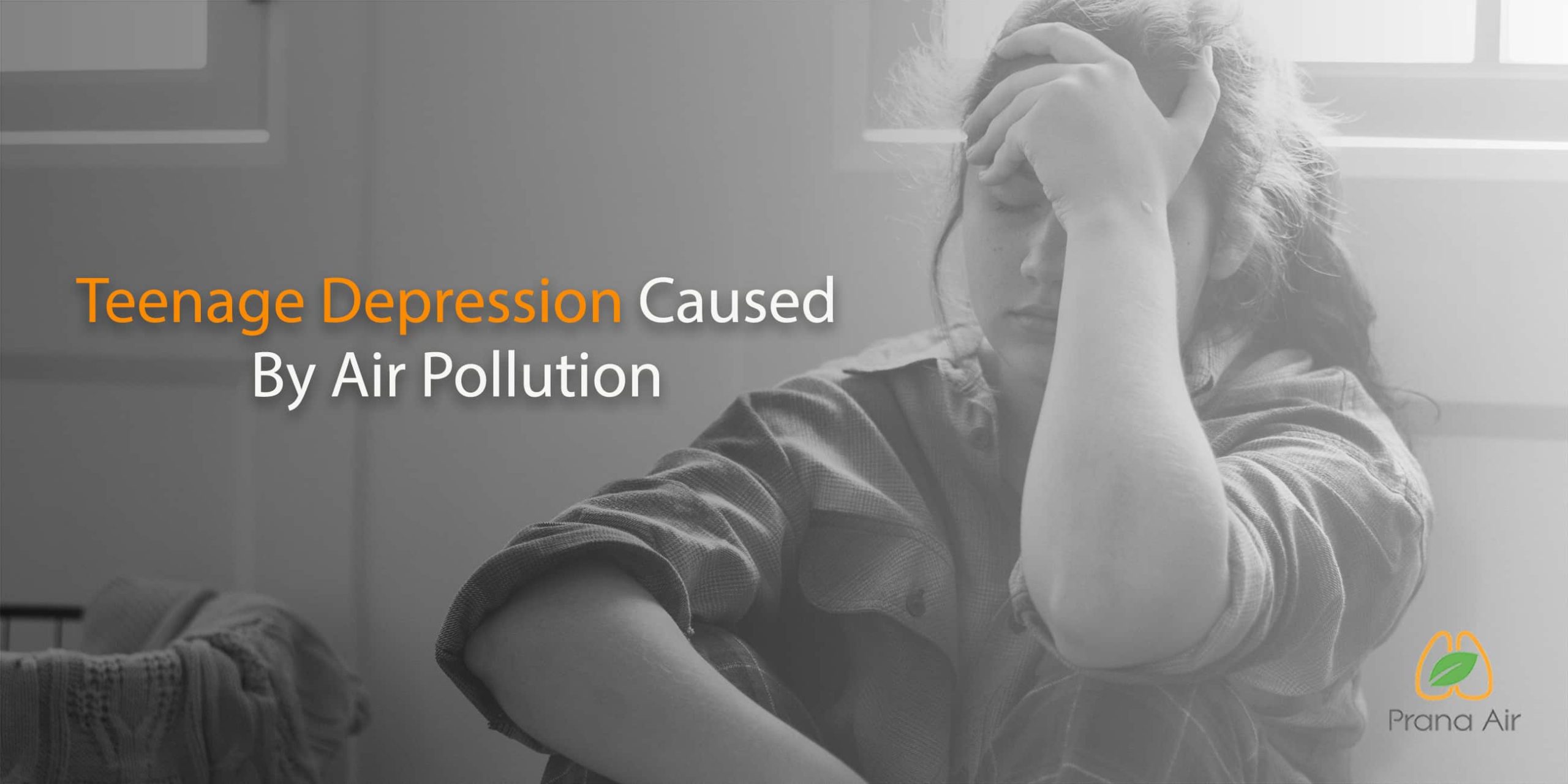Teenagers go through many bodily changes in their adulthood. For example, external factors such as air pollution and stressors make their life difficult. The stress caused by air pollution can lead to teenage depression and other effects on their bodies. As air pollution levels subsequently increase, so do the negative effects on the body and mind of adolescents. Here we will talk about-
- How Early Life Stress Due to Air Pollution Causes Teenage Depression
- Factors that lead to symptoms of depression in teens
- How teen depression exacerbates the effects of air pollution
- Other Health Impacts on Adolescents Due to Air Pollution
- Evidence-based effect of air pollution on adolescent depression
- How Air Pollution Hinders Child Cognitive Development
- How air pollution can affect their reproductive health
- What can be done/Solutions
- Conclusion
Introduction
Adolescent or adolescent depression is a severe mental illness. This leads to constant emotions of anxiety, sadness and boredom. Rising levels of air pollution may contribute to teen depression. As a result, these variables can delay the development and growth of the brain and body, especially during adolescence. Excessive exposure to carbon dioxide (CO2) and ozone (O₃) indoors can harm brain growth and function.
The term “air pollution” refers to the deterioration of air quality both indoors and outdoors. Various air pollutants suspended in the air are the cause of air pollution. A pollutant can harm different groups of people in different ways. However, this only happens when their levels exceed the desired limit.
The brain is an essential organ that helps in the functioning of the body. The whole body suffers when rising air pollution makes it harder for the brain to function. Air pollution affects other parts of the body such as the lungs, kidneys, liver and eyes.
Early age stress leads to Teenage Depression due to Air Pollution
PM2.5 & PM10, carbon monoxide (CO), O₃, nitrogen oxide (NO₂), and other air pollutants are all present in ambient air. Young adults spend more time outdoors than older adults. So, they are more sensitive to the negative impacts of these air pollutants. Teenagers who are exposed to toxic air for longer periods are more prone to experience stress.
Specialists have discovered a link between air pollution and an increase in heart diseases. This is immediately visible in a teenager’s body changes. The body can respond by raising heart rate, tensing muscles, rapid breathing, and sweating.
High levels of PM2.5, can provoke stress hormones. American Heart Association Journal Circulation Researchers published a study. They examined the origin of these harmful health impacts-
- Even a few hours of exposure to PM can cause swelling, metabolism shifts, and the release of stress hormones.
- During growth years, 50-70% of teenagers experience anxiety, impulse control, and agitative disorders.
If you or someone you know is facing any mental health issues, talk to a trusted adult or seek help.
– How increased air pollution levels lead to depression symptoms in teenagers?
Increased air pollution levels can cause mental illness because these pollutants increase the stress hormone cortisol. It further affects the levels of another chemical in the brain known as dopamine or the happy hormone. Changes in the level of the happy hormone lead to mental disorders and depression symptoms, for instance, low mood, lack of interest in your hobbies, feeling of worthlessness, etc.
Teenagers spend more time outdoors than older adults do. Thus, making them more open to the impacts of certain air pollutants. Certain pollutants cause the release of the stress hormone. Their sensitive bodies may develop mental health issues because their bodies are already sensitive to air pollution.
Factors that lead to Depression Symptoms

High amounts of O₃ and other pollutants in the outdoor air damage the brain’s functionality among teenagers. They spend more time outdoors than indoors. As a result, air pollutants like O₃ that are present outdoors can seriously impact them because they are more sensitive to the harmful effects of these pollutants.
A healthy brain is crucial for the sound functioning of the body. High levels of air pollutants make it difficult for youngsters to maintain a healthy and sound brain and central nervous system. Due to this, their bodies lag in basic body functions. These include basic cognitive and fine motor skills, oral and writing abilities, etc. They feel worthless which blows their self-confidence and often leads to depression.
Teenage Depression worsens Air Pollution effects
The effects of air pollution and teenage depression are interrelated. Teenage depression can be caused due to air pollution. Children suffering from anxiety or depression symptoms are more vulnerable to the side effects of air pollution. This means that a child suffering from anxiety or depression is affected more by air pollutants than a child with no mental illness disorders. The rate of mood disorders, depression symptoms, anxiety, and other mental health conditions among teenagers is increasing due to increasing levels of sadness, stress, loneliness, etc.
Bodies of depressed teenagers are already vulnerable because their will to live is lost. They don’t eat a balanced diet, drink sufficient water to keep their bodies hydrated, and constantly have suicidal thoughts. As a result, their bodies grow weaker and weaker because their bodily systems, for instance, the immune system, breathing system, and reproductive system, among others, get affected. Therefore, their bodies are more sensitive to the harmful effects of air pollution.
“All work and no play makes Jack a dull boy”
But is it worth risking Jack’s life when there are so many dangerous air pollutants outside? PM10, O₃, CO, NO₂, Sulphur dioxide (SO₂), and a variety of other pollutants can all be found at high levels in the outdoor environment. When compared to older adults, these pollutants can have a far greater impact on a child’s brain and other body organs.
- PM10- irritation in the eyes, nose, and throat. Affects lung functioning and delays lung growth.
- O₃- exposures cause swelling in the respiratory tract. That makes it difficult to take full, deep breaths.
- CO- inhaling CO prevents the body from using oxygen normally. Symptoms, for instance, headaches, nausea, vomiting, etc. can be seen among children and teenagers.
- NO₂- exposures can lead to severe lung damage. It reduces the functioning of the lungs, increases asthma attacks, and often ER visits.
- SO₂- The developing lungs of children are more sensitive to SO₂ emissions. Therefore, if a child has pre-existing asthma, SO₂ exposures can worsen their conditions.

Evidence-based impact of air pollution on teenage depression symptoms
The National Bureau of Economic Research (June 2018)
- The neurological impacts of air pollution, which can range from behavioral changes to cognitive illnesses, can have a severe impact on mental health.
Neurotoxicology Journal (May 2008)
- Respiratory, cardiac, and diastolic illnesses might adversely be affected by air pollution.
- PM are types of air pollutants that can cause the brain to experience inflaming responses. This can lead to mental health problems such as teenage depression.
The National Bureau of Economic Research (China, June 2018)
- The chances of developing a mental disorder (including teenage depression) rise by 6.7 % for every 1 standard deviation above the average PM2.5 levels. (Equal to yearly healthcare bills of 22.88 billion USD)
Cross-Sectional Study by Vert C (August 2017)
- For every 10 g/m3 rise in nitric oxide, the rate of depression symptoms increased by two times.
Medical report by Szyszkowicz M (2009)
- Every 19.4 μm of PM10 level increases the chances of ER visits for cases of depression by 7.2%.
Other Effects of Air pollution on Teenagers’ Health
Air pollution not only affects teenagers mentally but physically too. Following are various effects on the minds and bodies of teenagers as a result of air pollution:

1. Cognitive skills:
NO₂ is the most significant air pollutant affecting children’s cognitive development. Cognitive skills are the most important skills. The brain uses these skills while thinking, reading, memorizing, noticing, paying attention, making decisions, language awareness, and reasoning. These basic skills are vital for a child’s development and growth.
Traffic jams contribute significantly to outdoor emissions of NO₂ gas.
Tobacco smoke and emissions from stoves, ovens, and water heaters are instances of indoor emissions.
2. Fine Motor Skills:
Exposures from pollutants like PM2.5 and PM10 and airborne copper can lead to poor fine motor skills in children. The ability to make precise movements by small muscles in the hands and wrists comes under fine motor skills. These are an ongoing aspect of our daily life.
Particles are fine, breathable PMs released by diesel engine cars, road and construction dust, and open burning of coal. Indoor emissions are cooking, fireplaces, and wood burners, for instance.
We can find airborne copper in places like school grounds where a child spends 4-8 hours.
3. Sensorimotor Skills:
High-traffic areas, coal-fired power stations, and other sources that burn fuel are the sources of Black carbon (BC). High levels of Black Carbon outdoors can affect a child’s sensorimotor skills. Children learn about the world through their senses and motor activities as they get older. These are essential for developing a basic awareness of the environment they are in.
4. Lower IQ Levels:
PM, NO₂, BC, Isophorone (C9H14O), and Benzene compounds (C6H6) are the pollutants that can affect the IQ of a child at his initial age. Lower IQ will impact the academic results of a child, and professionally in the future. Having a good IQ means having a good mental ability. Good response time, cognitive functioning, short-term memory, oral and written skills, and numerical aptitude are measures of good mental ability.
C9H14O pollutes water near emissions of coal-fired plants. A child taking a bath with this polluted water or breathing in the polluted air by coal ash can come in contact with C9H14O.
High C6H6 exposure before birth affects a child’s IQ level at the age of 5.
5. Chronic Sadness and depression symptoms among Teens:
Sadness and teenage depression can be linked to exposure to O₃ in the ambient atmosphere. Longer O₃ exposures can cause chronic sadness, depression symptoms, lack of interest, and seclusion among teenagers.
6. Bodily Functions:
The ability to move different parts of the body like feet, legs, and hands comes under bodily functions. Bodily functions are important to carry out day-to-day activities.
Exposure to high levels of NO₂ can lead to poor bodily functions among children. At an early age, when body cells and organ tissues are developing, exposure to such pollutants can affect the growing stage of a child.
Air pollution hampers their Cognitive Growth
1 in every 5 children (aged 9–17 years) has a curable mental condition. That causes some disorders, and 1 in every 10 has a condition that causes considerable cognitive failures. (Says the American College of Obstetricians and Gynecologists)
Air pollution harms the bodies and the brain of teenagers. Their cognitive and muscular abilities can be adversely affected due to increasing levels of air pollution.
WHO experts say, “Air pollution exposures can harm maturity and growth of the teenagers. This leads to poorer performance on memory function and the emergence of behavioral disorders like autism spectrum and attention deficit hyperactivity syndromes (ADHS) can be seen as well.
The brain is compromised along with the hypothalamus gland, pituitary gland, and gonadal axis. The gonadal axis is a complex interaction between the hypothalamus and the pituitary gland.
Air Pollution and Reproductive problems
Rising levels of air pollution not only affect the young minds and bodies, but also the hormonal balance in young females and males. Common levels of NO₂ can influence both male and female reproductive health.

Air pollution is bad for a growing mind. The brain handles all hormonal balance in growing teenagers. The hypothalamus and pituitary gland are in charge of producing reproductive hormones. Air pollution can interfere with this process. Females may experience menstrual irregularities as a result. Stress also has an impact on both male and female reproductive health.
NO₂ sources are so prevalent that you will almost certainly come across one near you. As a result, that makes this gas even more dangerous. Among these sources are:
- Emissions caused by traffic jams
- Power plants and industrial emissions
- Construction and destruction work
- Tobacco smoke and fuel-burning appliances such as ovens and stoves are a few instances of indoor sources.
- Low fetal growth, fetal distress, preterm, stillbirths, and low birth rates in males are concerned with the occurrence, spread, illness prevention, and air pollution exposure.
- Metabolic disorders, amenorrhea cycles, and polycystic ovarian syndrome (PCOS) are among the harmful impacts of air pollution. (Research published in the International Human Reproduction report)
- 1 out of 5 women in India suffers from PCOS and other menstrual hygiene-related issues due to air pollution, changes in lifestyles, and stress.
Solutions
- To avoid these, youngsters should minimize their outdoor activities on days with poor air quality. Wear a good N-95 air mask outside to avoid the risk of harmful air pollution. Monitor the indoor air pollution in homes and schools. Take necessary or appropriate measures accordingly.
- Increase ventilation rate in homes and classrooms. Emissions such as CO2 are common indoors due to the respiration process. High CO2 exposure can damage cognitive ability and can affect academic results of the child.
- Parents should keep an eye on their child’s behavioral changes while avoiding helicopter parenting ideology.
- Regular exercise, yoga, meditation, and breathing exercises assist in reducing the impacts of stress and depression symptoms in teenagers. Their bodies can benefit from early morning yoga or evening walks.
- However, it is critical to monitor outdoor air pollutants as well as overall air quality before stepping outside. This is a critical measure that can prevent toxic air exposure, especially in very polluted areas.
- Maintain the indoor air quality when sensitive groups of people are present. Children, the elderly, pregnant women, and persons with underlying health issues such as heart disease, diabetes, and so on are among the sensitive groups of people.
Conclusion
Since teenagers’ bodies and minds are still in the developing stage, air pollution can affect their bodies. The bodies of teenagers go through various changes already. Exposure to air pollution can alter their normal body functions that make their bodies susceptible to catching diseases.
Air pollution can worsen respiratory diseases, thinking abilities, depression symptoms, and panic attacks. Menstrual disturbances in the female body are caused due to air pollution.
The living conditions and surrounding environment plays an important role in adding to the stress and teenage depression. Therefore, air pollution exposures effects bodily functions other than mental health issues.







